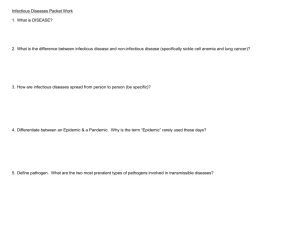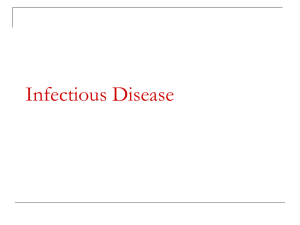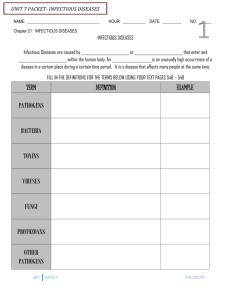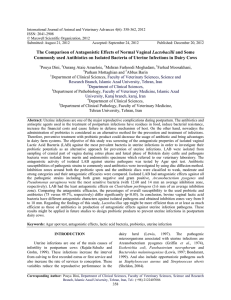b1_diet__disease
advertisement
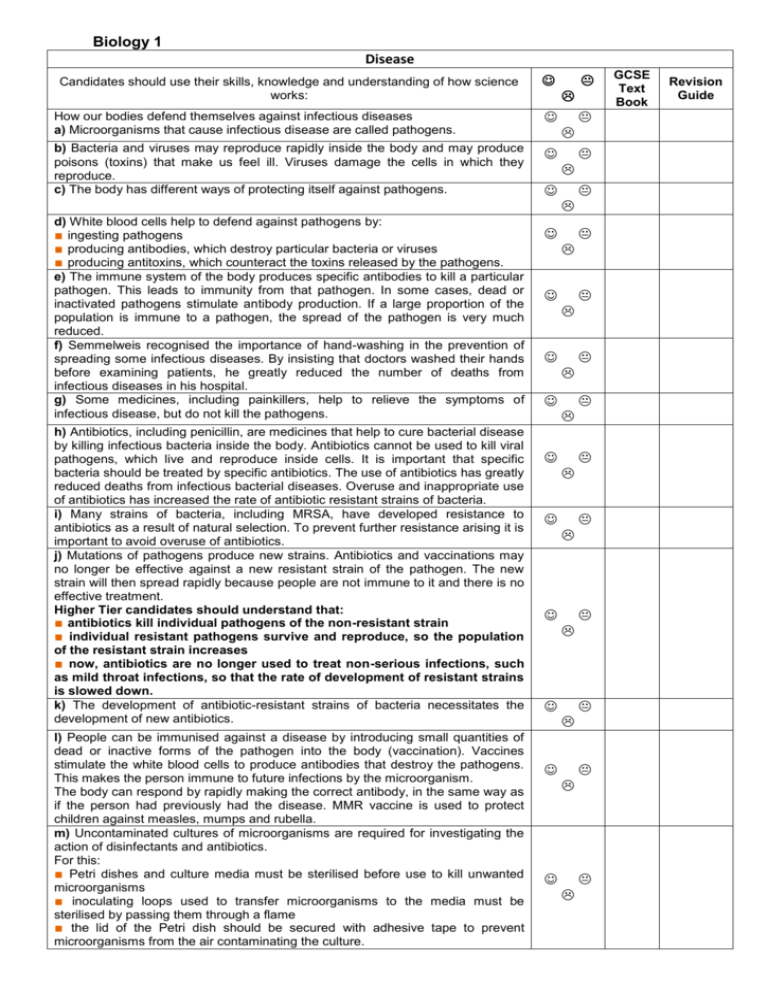
Biology 1 Disease Candidates should use their skills, knowledge and understanding of how science works: How our bodies defend themselves against infectious diseases a) Microorganisms that cause infectious disease are called pathogens. b) Bacteria and viruses may reproduce rapidly inside the body and may produce poisons (toxins) that make us feel ill. Viruses damage the cells in which they reproduce. c) The body has different ways of protecting itself against pathogens. d) White blood cells help to defend against pathogens by: ■ ingesting pathogens ■ producing antibodies, which destroy particular bacteria or viruses ■ producing antitoxins, which counteract the toxins released by the pathogens. e) The immune system of the body produces specific antibodies to kill a particular pathogen. This leads to immunity from that pathogen. In some cases, dead or inactivated pathogens stimulate antibody production. If a large proportion of the population is immune to a pathogen, the spread of the pathogen is very much reduced. f) Semmelweis recognised the importance of hand-washing in the prevention of spreading some infectious diseases. By insisting that doctors washed their hands before examining patients, he greatly reduced the number of deaths from infectious diseases in his hospital. g) Some medicines, including painkillers, help to relieve the symptoms of infectious disease, but do not kill the pathogens. h) Antibiotics, including penicillin, are medicines that help to cure bacterial disease by killing infectious bacteria inside the body. Antibiotics cannot be used to kill viral pathogens, which live and reproduce inside cells. It is important that specific bacteria should be treated by specific antibiotics. The use of antibiotics has greatly reduced deaths from infectious bacterial diseases. Overuse and inappropriate use of antibiotics has increased the rate of antibiotic resistant strains of bacteria. i) Many strains of bacteria, including MRSA, have developed resistance to antibiotics as a result of natural selection. To prevent further resistance arising it is important to avoid overuse of antibiotics. j) Mutations of pathogens produce new strains. Antibiotics and vaccinations may no longer be effective against a new resistant strain of the pathogen. The new strain will then spread rapidly because people are not immune to it and there is no effective treatment. Higher Tier candidates should understand that: ■ antibiotics kill individual pathogens of the non-resistant strain ■ individual resistant pathogens survive and reproduce, so the population of the resistant strain increases ■ now, antibiotics are no longer used to treat non-serious infections, such as mild throat infections, so that the rate of development of resistant strains is slowed down. k) The development of antibiotic-resistant strains of bacteria necessitates the development of new antibiotics. l) People can be immunised against a disease by introducing small quantities of dead or inactive forms of the pathogen into the body (vaccination). Vaccines stimulate the white blood cells to produce antibodies that destroy the pathogens. This makes the person immune to future infections by the microorganism. The body can respond by rapidly making the correct antibody, in the same way as if the person had previously had the disease. MMR vaccine is used to protect children against measles, mumps and rubella. m) Uncontaminated cultures of microorganisms are required for investigating the action of disinfectants and antibiotics. For this: ■ Petri dishes and culture media must be sterilised before use to kill unwanted microorganisms ■ inoculating loops used to transfer microorganisms to the media must be sterilised by passing them through a flame ■ the lid of the Petri dish should be secured with adhesive tape to prevent microorganisms from the air contaminating the culture. GCSE Text Book Revision Guide n) In school and college laboratories, cultures should be incubated at a maximum temperature of 25°C, which greatly reduces the likelihood of growth of pathogens that might be harmful to humans. o) In industrial conditions higher temperatures can produce more rapid growth. Strengths: Weaknesses: To Improve I need to: ……………………………………………………… ……………………………………………………… ……………………………………………………… ………………………………………………………………… ………………………………………………………………… ………………………………………………………………… ………………………………………………… ………………………………………………… ………………………………………………… Keeping healthy Candidates should use their skills, knowledge and understanding of how science works: GCSE Text Book Revision Guide Diet and exercise a) A healthy diet contains the right balance of the different foods you need and the right amount of energy. Carbohydrates, fats and proteins are used by the body to release energy and to build cells. Mineral ions and vitamins are needed in small amounts for healthy functioning of the body. A person is malnourished if their diet is not balanced. This may lead to a person being overweight or underweight. An unbalanced diet may also lead to deficiency diseases or conditions such as Type 2 diabetes. b) A person loses mass when the energy content of the food taken in is less than the amount of energy expended by the body. Exercise increases the amount of energy expended by the body. c) The rate at which all the chemical reactions in the cells of the body are carried out (the metabolic rate) varies with the amount of activity you do and the proportion of muscle to fat in your body. Metabolic rate may be affected by inherited factors. d) Inherited factors also affect our health; for example cholesterol level. e) People who exercise regularly are usually healthier than people who take little exercise. Strengths: Weaknesses: To Improve I need to: ……………………………………………. …………………………………. ……………………………………………. …………………………………. ……………………………………………………………………………… ………………………………………………………………………… ……………………………………………. …………………………………. ……………………………………………………………………………… …………………………………………………………………………


